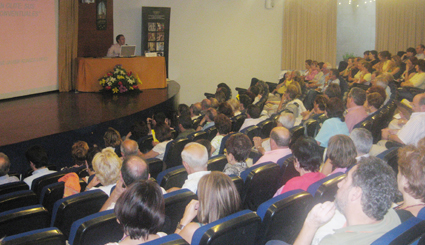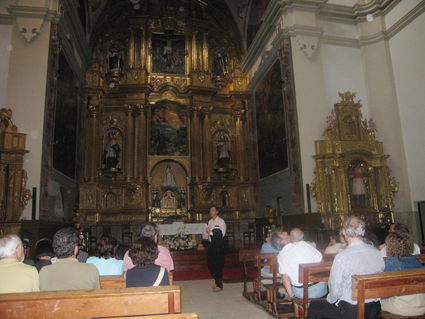BRINGING HERITAGE CLOSER. OLITE, ROYAL SEAT
29 August 2007
Religiosity and artistic promotion in Olite: its convent complexes
Mr. Javier Azanza. Chair of Navarrese Heritage and Art
After a general introduction to the convents of Olives, Professor Azanza focused his talk on the Apostolic high school of San Francisco, dividing it into three sections.
First of all, he went to reference letter to the historical and foundational antecedents, which date back to the Middle Ages average , the Franciscan convent being a royal foundation that benefited from the generosity of the queen dowager Doña Juan, Carlos II, Carlos III el Noble and his daughter Doña Blanca.
In a second part, he dealt with the great transformation that the convent underwent in the middle of the 18th century and the reasons that led to it. One of them was the erection in 1745 of the Olives convent at high school of Apostolic Missionaries, which forced a profound remodelling of the building to adapt it to its new function. Nor should we forget the effects of the Lisbon earthquake of 1 November 1755, which was felt in the convent and ended up ruining its conventual church.

Finally, Professor Azanza explained the mechanisms through which the Franciscan convent achieved the financial aid of generous benefactors who made this transformation possible. He specified the most relevant ones, starting with the royal sponsorship to position of the monarchs Ferdinand VI and Charles III, who contributed financially and through the exchange of land. An important role was played by Francisco de Mendinueta, a Navarrese living in the Court who understood the royal finances and became the real driving force behind the Olitense convent, to the point that the religious community gave him the gift of a chapel board of trustees in which to place his coat of arms. Other important figures such as Don Alejandro de la Vega, Doña Bernarda Munárriz from Tafalla and the Marquis of Feria also made generous donations, as did the Viceroy Francisco de Paula Bucarelli y Ursúa, who established a close relationship with the Franciscan monks during his stay in Olite between 1778 and 1779.
The generosity of the aforementioned benefactors, and the disinterested financial aid of the residents of Olite, allowed the construction of the convent complex between 1749 and 1763, and the endowment of its decoration with altarpieces, sculptures and paintings, a process in which outstanding artists and master builders took part.

Church of the convent of San Francisco de Olite
PROGRAM
MONDAY, 27TH AUGUST
Place: Olite. Cultural Centre
16.30 h: Opening and presentation of the course
16.45 h. The urban development process of a town in the area average Navarra: Olite
Prof. Carmen Jusué. University of Navarra
17.45 h. Coffee break
18.15 h. The parish of San Pedro
Prof. Asunción Domeño. Chair of Navarrese Heritage and Art
19.15 h. Guided tour of the town centre of Olite
Prof. Javier Corcín. high school Prince of Viana. Olite
TUESDAY, 28TH AUGUST
Place: Olite. Cultural Centre
16.30 h. The mural paintings of Olite during the Gothic period
Prof. Carmen Lacarra. University of Zaragoza
17.30 h. Coffee break
18.00 h. Santa María la Real de Olite: a living heritage
Prof. Mercedes Jover. Chair of Heritage and Navarrese Art
19.00 h. The Palace of Olite, project and the construction of a royal setting
Prof. Javier Martínez de Aguirre. Chair of Navarrese Heritage and Art
WEDNESDAY, 29TH AUGUST
Place: Olite. Convent of San Francisco
16.30 h. Devotion and the plastic arts in the 17th and 18th centuries
Prof. Ricardo Fernández Gracia. Chair of Navarrese Heritage and Art
17.30 h. Coffee break
18.00 h. Religiosity and artistic promotion in Olite: its convent complexes
Prof. Javier Azanza. Chair of Heritage and Navarrese Art
19.00 h. visit Guided tour of the rooms of the Convent of San Francisco
THURSDAY, 30 AUGUST
Place: Olite. Cultural Centre
16.30 h. The painter Pedro de Aponte in Olite
Prof. Carmen Morte. University of Zaragoza
17.30 h. Coffee break
18.00 h. Closure: Evocation and reality: the image of Olite in the 19th and 20th centuries.
Prof. Ignacio J. Urricelqui. Chair of Navarrese Heritage and Art
19.00 h. visit to the Pagos de Araizwineries

